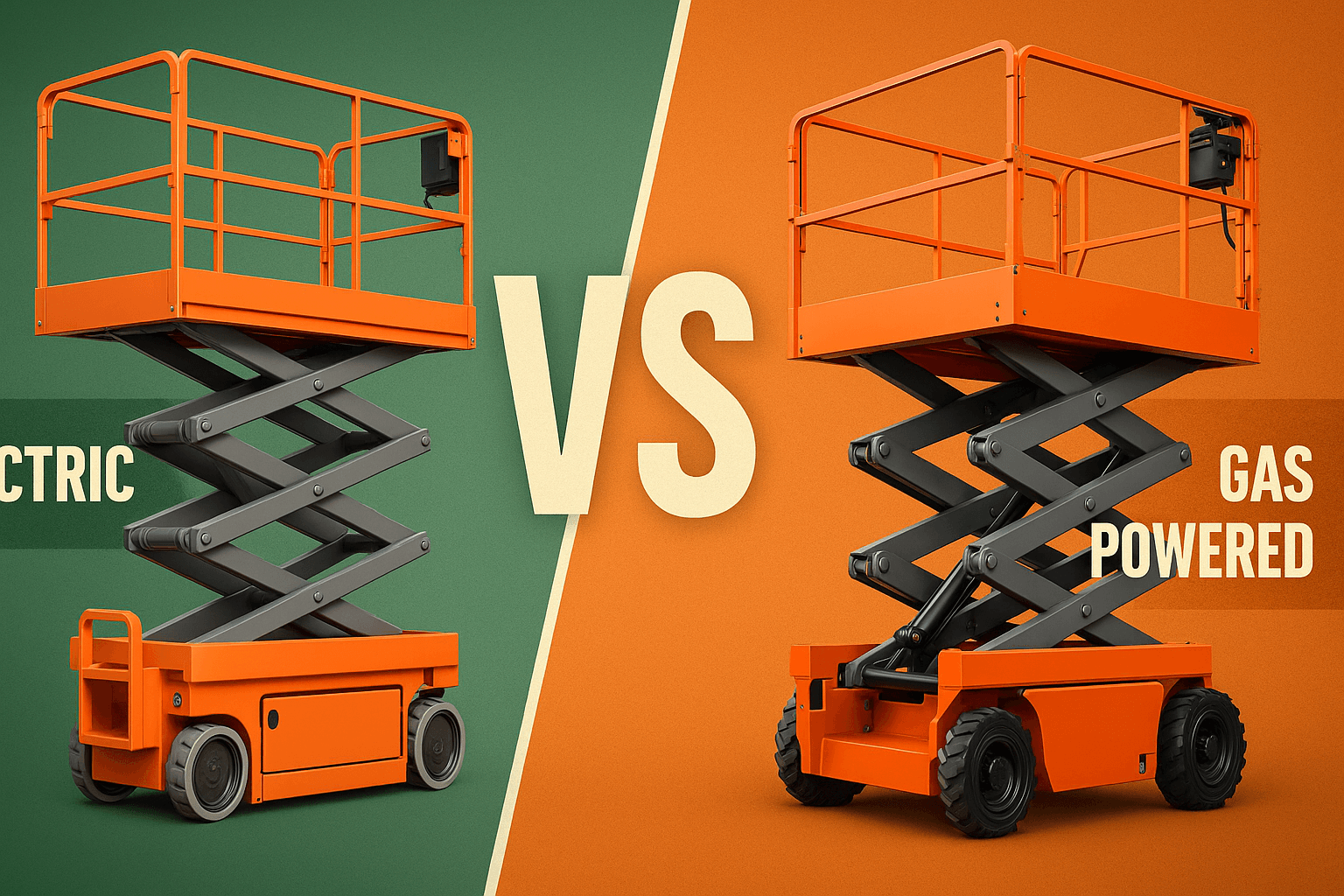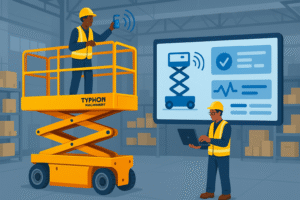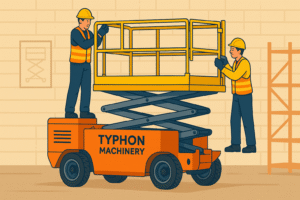Electric vs. Gas-Powered Scissor Lifts
The choice of whether to select electric or gas-powered scissor lifts can impact your job to a large extend. And cost! Are you in doubt about the right choice? Which type of scissor lift will be the most suitable one for your project for 2024? In case you are still wondering, you are not alone.
Due to new technologies and the changes in the workplace, it has really become difficult to make a choice. Furthermore, electric versions have not only zero emission and soundless, but they are also cleaner when compared to their gas-powered counterparts, while the gas-powered ones cannot only work indoor/outdoor but also have longer runtime and are more powerful. However, considering the issue of the above would be more favourable. In this inclusive guide, we will discuss in detail:
- Key distinctions between the electric and gas scissor lifts.
- The particular benefits and the drawbacks of each type
- Use of real examples and the factors that affect the performance level
- Expense reasons and the influence on the environment
- Recommendations from expert sources for different situations.
Let us help you decide on the right scissor lift model which matches your needs perfectly
Key Takeaways:
- Electric scissor lifts are great for indoor settings by emitting no CO2, no vibrations, producing low noise, and less maintenance cost, and suitable for retail shops and production facilities as great.
- Gas-powered scissor is superfirst-class for outside terrains and tough surfaces, with solid power and longer runtime, which fits well for construction and rural projects.
- However, it may not be just the initial purchase price; other factors will also be significant, such as fuel costs, the need for regular maintenance, and how long the lift can be used for industrial purposes.
- On the other hand, electric types are the most desirable in terms of CES because they save energy, are safe for indoor air, and do not emit gases harmful to health.
- The choice to select such a device should depend on the specific work environment, the platform needed, the frequency of use and the job requirements.
Understanding Scissor Lift Power Sources
The power source of a scissor lift has a major role and plays a critical function in the lift’s performance, energy utilization, and usage field. Let’s have a look at the multi-source of the power used in these lifting machines and compare their main features.
Electric-Powered Scissor Lifts
In recent years, the method of using electricity has become the first choice for the majority of people concerning the facing of the elevating mechanism. These are battery-run machines that can be recharged with electricity, thus very advantageous for indoor usage without causing any air pollution. Such power provides smooth, even performance in an environmentally friendly way in addition to this, it gives off no exhaust at all.
The latest electric models of a scissor lift include a new generation of batteries capable of providing the same level of power consistently to work throughout the day. They generate very little noise making them applicable to the most stringent environmental regulations and the best choice for environments requiring low noise levels like clinics, offices, or shopping malls. Moreover, electric power needs little maintenance in comparison with gas-powered systems.
Gas and Diesel-Powered Scissor Lifts
Scissor lifts which are powered by petrol and diesel fuels are having two major advantages, powerful performance, and a prolonged run time. These types of machines can be used in the open air and rough terrains where the electrical outlet for the charging is not easily accessible. The gas motor is very stable and does not require recharging and it can easily accomplish high loads.
Diesel-powered units are generally known for their high torque and lifting capacity when compared to the electric ones. They can perform well in construction, mining, and other heavy-duty operations where high power is the main thing needed. Nevertheless, these machines are polluting as they emit and also their fuel system should be serviced regularly to ensure the right performance.
💡 Key Takeaway: The selection of a scissor lift has been known for its electric and fuel variety in the market. The electric lift is best for indoor, emission-free work setups while the gasoline-powered lift is a great choice for outdoor applications and heavy-duty projects owing to a higher level of power it possesses.
Differences in Performance Capability
Power Output and Lifting Capacity
There’s a marked difference in the power output and the platform capacity between the electric and fuel-powered scissor lifts. Usually, the gas lift is much better in the context of total power, that is to say, it is more powerful and its lifting capacities reach 1,500 to 4,000 pounds. They employ very powerful engines that give a continuous power supply, thus, making them suitable for very tough operations.
Although the lifting capacities of electric scissor lifts are less, that is in the range of 500 to 2,500 pounds, they can still perform efficiently. What they do best is accurate load handling and smooth working, which gives them the edge of being used for indoor applications where controlled movements are key.
The power and operation time
The gas operated lifts provide longer work time since they can be refueled very quickly, thus enabling minimal downtimes. Additionally, these machines deliver even energy throughout the operational time, notwithstanding the load and environmental situations.
The electric kind which gets its power from batteries normally offers between 4 and 6 hours of uninterrupted functionality before it has to be recharged. Such a seeming limitation, however, is usually balanced by those models’ high power efficiency and low operating costs. Moreover, with modern electric lifts, there are cutting-edge battery management systems that not only reduce battery use but also prolong the running time.
What can these machines do on different ground?
When the ground is tough, gas-powered lifts are the ones to go for, hands down. Their reliable power units and heavy-duty engineering ensure they have an easy pass through the hard parts, the rough areas, and steep slopes. Without losing the possibility of going multiple stories up, they can do that even on difficult ground, which makes them a convenient choice for jobs outdoors.
Electric scissor lifts, however, thrive on flat, solid surfaces. Some of them are built to handle challenging terrains, but their performance is still subpar compared to gas-powered ones. On the other hand, finished floors and sensitive surfaces can take advantage of this type of lift which is lighter with more precise control.
💡 Key Takeaway: Gas-powered lifts are better for tasks that demand a power increase and the capacity to drive across hard terrain, while electric ones are best for power control procedures that require greater efficiency. Application, weather, and surroundings affected the decision.
Application-Specific Considerations
Indoor Applications
Indoor retail and manufacturing establishments often employ electric scissor lifts. Electric scissor lifts are ideal for inside settings without natural ventilation since they don’t produce pollutants.
Silence keeps consumers interested, supports workers’ job, and doesn’t cause pain. This also reduces nearby noise pollution. Electric lifts work best on level, smooth interior surfaces.
The tiny frame of these lifts makes them easier to handle in limited places, racks, and near fixtures. Clean rooms in electronic assembly facilities and food manufacturing charge-chambers are suitable places to use this technology.
Outdoor and Construction Use
Gas-powered scissor lifts are best for construction and outdoor applications. Their all-terrain capabilities and power output make them better than electric scissor lifts. They enable these devices to function upright on steep, sandy, and rocky terrain without compromising durability or performance.
In remote areas with little charging energy, such gadgets are invaluable. Gas-powered machines have a longer working duration and faster refilling, so they require minimum downtime. Higher power output is better for lifting weight and reaching higher altitudes, which is essential for outdoor building maintenance and construction.
Electric or gas lifts rely on your working environment and needs. For clean, quiet inside operation, electric versions are preferred. Outdoor and construction applications favor gas-powered machines’ versatility.
💡 Key Takeaway: Electric scissor lifts should, therefore, be preferred for indoor spaces like retail and industrial facilities, but outdoor construction projects and rough terrain applications do better with gas-powered ones.
Maintenance and Operating Costs
Regular Maintenance Requirements
Generally speaking, electric scissor lifts are accompanied by lower maintenance costs compared with those running on gasoline. The reason is simple, electric motor technology is not complicated hence such lifts have fewer movable parts which may become used or broken. Regular maintenance, in this case, is centered on taking care of the battery, inspection of the hydraulic fluid level and performing electrical connections checks.
In contrast, gas-powered lifts are aware of their engine components being intricate and they, therefore, need energy and attention more so. These lifts require a change of oil, the maintenance of the fuel system, and engine tuning quite regularly. These additional tasks are invariably responsible for the expansion of the loss of production time and the included operating costs.
Long-term Cost Analysis
When calculating scissor lift prices, consider both the original investment and long-term ownership costs. Electric versions are normally more expensive at first, but they become more cost-effective over time owing to decreased running costs and upkeep.
While gas-powered elevators may seem cheaper, they increase costs. Fuel alone may deplete your finances, especially if gas prices are unpredictable. Additionally, more regular maintenance will increase labor and component expenses.
The electric lift also can give you the opportunity to gain profit through:
- The energy cost being lower than the price of the fuel
- The reduction in frequency and complexity of maintenance
- The number of replacement parts being less
- The operational lifespan being longer
- Repairs nesting the period of time the equipment is out.
💡 Key Takeaway: Even though it could be more expensive to buy the electrically driven scissor lift at the beginning, their minimum maintenance requirements and lower operating cost weigh in favor of the electrically powered model in the long run compared to gasoline alternatives.
Environmental Impact and Regulations
Emissions and Noise Considerations
When comparing electric scissor lifts to gasoline ones, the environmental impact is a deal-breaker. Full-electric boom lifts emit no emissions, making them acceptable for use in environmentally protected structures. These equipment are the greatest contributions to construction and maintenance carbon footprint reduction.
Noise is important for the environment. The quiet electric type is preferable in such circumstance. Most electrical lifts operate quietly. These lifts normally make 70 decibels, but gasoline-powered variants may make 85 dB, which requires ear protection and disturbs noise-sensitive areas.
Safety Standards and Training
Safe to say that both electric and gas-powered scissor lifts should be in compliance with the safety regulations and standards laid down and adhered to in the industry.
Regardless of the power source, operators should have the required training certifications. On the other hand, electric models usually have safety features in addition to the ones that are there which are the battery systems and electrical components.
Checking for regulatory compliance is not enough, there should be regular inspections and maintenance to be sure that the environment is not affected in any way. This may include the verification of the emission levels of gas-powered machines and the proper disposal of batteries for electric models. Many of the jurisdictions now insist upon the documentation of these compliance measures with the environment as part of getting operation permits.
💡 Key Takeaway: Without releasing any pollutants and a smaller amount of noise, electric scissor lifts provide you with the chance to become green while at the same time, both types are to be compliant with safety and environmental regulatory bodies in operation.
Making the Right Choice
Choosing the right scissor lift, whether it’s electric or gas-powered, should certainly not be a difficult task. It is very possible to simplify the task of decision making by discussing the essential aspects that will make things clear to you at the right time.
Project-Specific Requirements
Matching your project needs to the optimum lift type requires a careful examination of critical parameters. The work environment—mostly inside or outdoors—is examined. Electric scissor lifts are silent and emission-free, making them suitable for interior tasks. Gas-powered lifts may be ideal for outside construction or long-term jobs.
First, check the terrain where you intend to employ the lifting mechanism. Gas-powered lifts are sturdy and give more power on rocky or uneven terrain, while electric types work best on smooth inside surfaces.
Selection Criteria Checklist
Put your mind at ease by sticking to these most important points so that you can be sure you will never make a wrong decision:
- The place of work
- Indoor or outdoor usage
- The state of the surface
- The amount of ventilation needed
- The work that requires to be done
- What is the required height of the lifting
- How much weight does it have to carry
- For how long will it be used per day
- The structure of the machinery
- Availability of the charging stations
- Fuel is readily available
- The places for keeping the goods
Remember, the choosing of the proper scissor lift is not just about fitting the current need but tends to be also the aspect of long-term such as maintenance costs and environmental regulations of the area. This plan of action will guide you to decide an appropriate lift without much puzzle that can make the most of your needs.
💡 Key Takeaway: You are able to pick out the most appropriate scissor lift only by going in for a serious the comparison of your project requirements, the working environment, and the operational needs as well as by taking into account the long-term parameters such as maintaining and regulatory obligations.
Final Thought for a Discussion
As distinct machinery, electric and gas-powered scissor lifts are built differently to achieve a goal. This depends on the location, length, and operational demands of your project. Indoors, electric scissor lifts excel due to their zero emissions, silent operation, and minimal maintenance costs, making them ideal for retail, manufacturing, and HVAC operations.
Outdoor building sites and difficult terrain are ideal for petrol-powered lifts, which provide the maximum power and longest operating duration for tough operations. Consider fuel, maintenance, and environmental consequences beyond initial expenses. Consider your demands, safety requirements, and long-term objectives when choosing an electric or petrol-driven lift. Thoroughly evaluate project needs and consult with equipment rental firms for guidance on making the proper choice.
FAQs
What is the average life span of the scissor lifts electric vs gas?
When properly maintained, electric scissor lifts usually last 8-10 years, and the gas-powered ones last 6-8 years in the usual case. Electric models are generally the likely candidates for longevity because they have fewer moving parts and less mechanical stress, hence requiring less maintenance over time.
How much does it cost to charge an electric scissor lift compared to fuel costs for gas models?
An electric scissor lift can be charged for approximately $3-5 per one full charge, while gas-powered lifts can consume $15-20 worth of fuel per day. The cost of recharging an electric model depends on the local electric price, but it is cheaper for daily operations. However, this may be the case only if the electric price is low and the charging lasts for only a day. In short, a gas-powered lift is best if daily operations are executed at a fast pace.
Can electric scissor lifts operate in wet conditions?
Electric scissor lifts are the best types for moving around in light rain normally, but besides that, they are not suggested for heavy rain or standing water. Also, there is a strict need for the electrical parts protection. Gas lifts, on the other hand, are generally recommended for wet conditions although some precaution is still necessary.
What is the charging time for electric scissor lifts?
With the standard charging equipment, most electric scissor lifts will need 6-8 hours but the time depends on how fast it is charging. There is an alternative for a quick-charge, which can reduce the charging time to 3-4 hours, but it will reduce the battery life eventually of course.
How are the weight capacities different between electric and gas scissor lifts?
The usual rangers are gasery, and they are usually the ones that have a platform capacity of 1,500 to 2,500 pounds. On the other hand, we are used to electric scissor lifts with a platform capacity of 500-1,500 pounds. With their lifting ability to this heavy load, gas-fuelled lifts have become a requirement for most construction projects besides having a large pool of the transport equipment.
Do environmental regulations restrict the use of gas scissor lifts indoors?
Definitely, there are numerous, if not all, regions that have regulations on using gas-powered machines indoors because of the release of emissions, which are very harmful to public health. One of the most common ways to make indoor scissor lift activities eco-friendly is to use electric models that comply with the workplace health and safety standards and the relevant air quality requirements.




